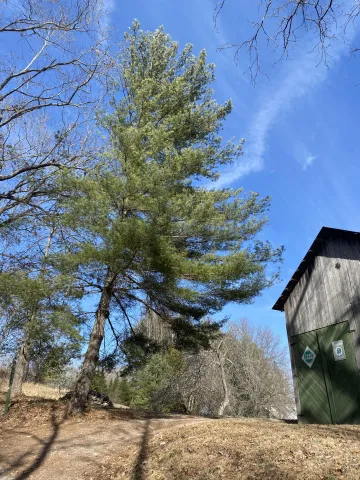White Pine: A Tree With History

White pine is a handsome tree and easy to identify by its blue-green needles and limbs forming in whorls.
By Steve Roark
Volunteer Cumberland Gap National Historical Park
Eastern White pine is a very handsome tree widely used for landscaping, windbreaks, and visual barriers. It can be hard to find in natural stands here locally, and most of what you see has been planted. There is also a species west of the Mississippi called western white pine.
Eastern white pine (Pinus strobus) is a cool climate species mostly concentrated in the northeastern states, but it follows the Appalachian Mountains down our way. It is a very straight, tall tree that has the unique habit of growing its limbs in whorls around the trunk. The whorls are from 1 to 4 feet apart, and each represents a year’s growth. So if you can see to the top of the tree you can age it. The needles are a pleasant blue green color, fairly thin, and grow in clusters (called fascicles) of 5. Other pines have needles in fascicles of 2 or 3. The bark is brown to black and thick on older trees, but smooth and greenish brown on younger ones. The cone is long and skinny, often curling like a banana.
White pine was present in huge virgin groves when Europeans first arrived. It instantly became the most valuable export the early colonies had. The wood was soft but strong, both valued characteristics to a society working wood primarily with hand tools. The long, straight trunks were prized by the British Navy, who used them for ship masts. Part of the controversy that led to the Revolutionary War was over representatives of the Crown marking and preserving the biggest and best white pine for the King’s Navy. New England was literally built from white pine, both as an export and local building material. Everything from homes to matchsticks was made from it. Only when technology provided saws and tools that could handle the harder wood of southern yellow pine did white pine drop in popularity, along with the fact that all the virgin white pine was cut out by 1900. But for 300 years, white pine was King of the wood industry.
Native Americans and early colonists used white pine as a medicinal. The inner bark was used as a tea to treat a cough and congestion. A tea made from the needles was used to treat a sore throat and used as a poultice to treat headaches. Rosin from the tree was made into a salve.
For landscaping, white pine is good to plant on the north side of the house to provide a windbreak and can be planted in a small cluster to provide thermal shelter for wildlife, especially birds. Doves seem partial to roost in white pine stands. For timber, white pine is fast growing and relatively free from insect and disease problems. Contact your local forestry office for more information on growing these fine trees.
- Log in to post comments